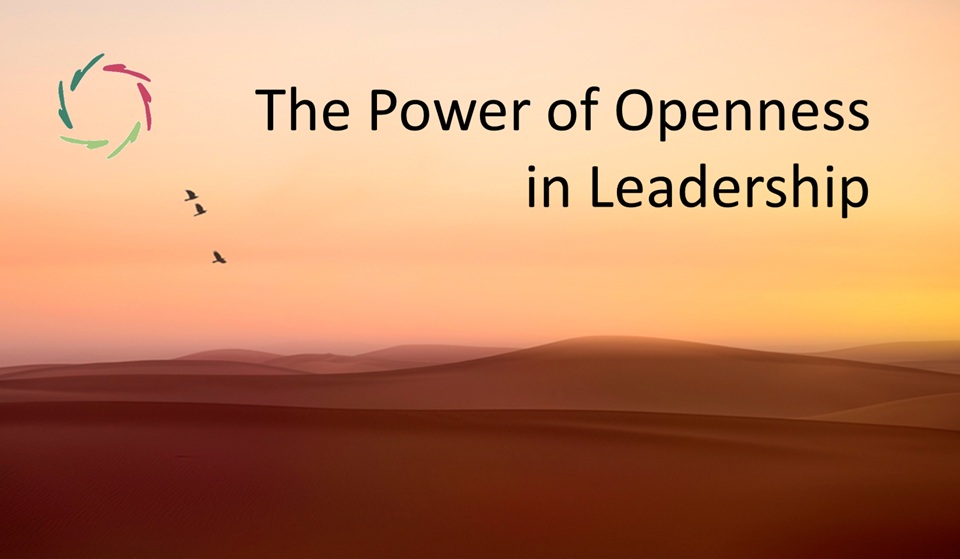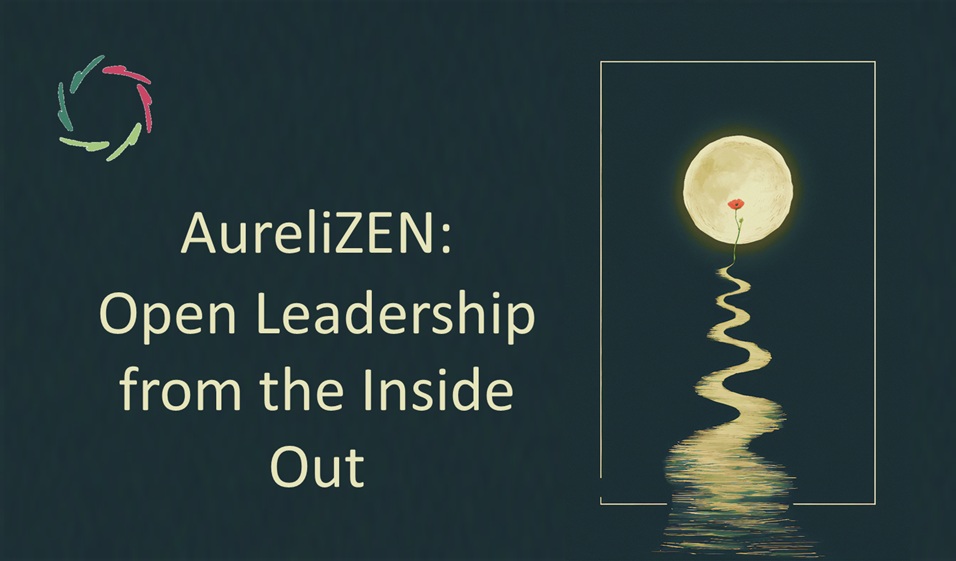The Power of Openness in Leadership

Openness is often mistaken for softness, yet it may be the deepest source of power a leader can have. It brings clarity rather than confusion, trust rather than fear, and adaptability rather than control.
This blog explores how Openness functions as a real-world power — subtle yet transformative. The key facets of this power are summarized in the addendum table, allowing you to experience the text without needing to hold its structure in mind.
The meaning of Openness
In everyday language, openness often means being transparent or accessible. In the AURELIS sense, Openness (with a capital) reaches further. It is a way of perceiving and of being — a full presence that includes depth, nuance, and honesty. As explained in Why We Write Capitals on Some Terms, the capital letter signals a lived reality, not a mere concept.
In leadership, this kind of Openness means being receptive while also showing oneself truthfully. It is the space where perceiving and expressing meet. Power grows there because truth begins to flow freely — not only from leader to others but within the group itself. When people sense this authenticity, they relax into cooperation. What follows is not obedience but resonance.
Openness creates trust
Trust cannot be demanded; it can only be evoked. It arises when a leader hides nothing essential. This doesn’t mean disclosing every thought, but letting sincerity become visible through tone, timing, and silence. Such Openness is felt, not declared.
In Empathy in 1, 2, 3 – Part 2: Openness, Lisa describes empathy as ‘not standing in the way.’ Trust grows from that same space of unobstruction. When a leader embodies it, others can breathe freely. They stop defending and start contributing.
Organizations built on such trust waste less energy on control. The Open leader gains authority not by hierarchy but by credibility. Real leadership begins when people want to follow because they feel safe in truth.
Openness makes perception more accurate
Leadership begins with seeing. But the clarity of perception depends on the perceiver’s Openness. Fear, bias, and self-importance distort the view; Openness clears the lens.
An Open mind perceives more of reality — the spoken and the unspoken, the rational and the intuitive. This leads to decisions that are both humane and effective. In the same blog on Empathy, this expanded perception is described as seeing ‘meaningful patterns.’ An Open leader can sense these patterns in people, organizations, or conflicts before they become visible to others.
This precision of perception is power in itself. It allows the leader to act with confidence that comes not from control but from contact with what is real.
Openness influences through resonance
When Openness is genuine, it radiates. People feel authenticity before they can explain it. This creates an invisible field of influence — subtle, yet deeply effective.
This resonance is a form of spontaneous autosuggestion. It doesn’t convince; it invites. In Why We Write Capitals on Some Terms, this effect is described as language that opens a doorway to depth. Similarly, Openness in a person opens such a doorway in others. The influence spreads not through words but through presence.
A leader who is Open in this way doesn’t need to exert pressure. Others begin to Open themselves, aligning naturally. Power becomes not domination but shared vitality.
The visible strength of Openness
People notice who has influence over others. They see when a certain calm or clarity enters the room with someone. Even without understanding, they respect it.
When Openness brings change, observers sense something real happening — cooperation deepening, tension softening. That recognition creates authority without force. In Open Leadership is Bigger than You, Lisa describes how true authority arises when ego and depth are integrated — the island resting on its mountain. The leader who embodies this balance becomes a stabilizing center.
Such visibility gives Openness social power. It influences not by loudness but by gravity. People align with it because it feels genuine, not because they are told to.
Openness fosters adaptability
Life changes constantly; leadership must do the same. A closed system resists change and eventually breaks. An Open system adapts and grows.Openness turns uncertainty from threat into opportunity. The leader who listens instead of defending transforms disruption into information. This flexibility is not weakness but responsiveness — the intelligence of life itself. The ability to perceive and adapt in real time, as seen in Empathy in 1, 2, 3 – Part 2: Openness, allows the leader to sense where the next step should occur.
Under such guidance, teams become more creative and resilient. Fear turns into curiosity. The organization, instead of surviving change, learns through it.
Openness transforms conflict into creativity
Conflict is inevitable. What matters is the attitude brought to it. A closed leader fights difference; an Open leader welcomes it. Openness turns confrontation into co-creation.
As shown in Open Vision on Leadership, Open Leadership makes disagreement a source of meaning rather than division. Tension becomes the spark of innovation. People can express their views fully without fear, knowing the space is safe.
This form of power is generative. It doesn’t suppress energy but channels it. Creativity and unity emerge not from sameness, but from the courage to stay Open within difference.
Openness disarms corruption
Corruption hides in darkness. Openness brings light. Manipulation cannot survive in transparent presence because it loses the shadows it depends on.
As described in Ethical Leadership is Open, ethical leadership grows from alignment between inner and outer reality. When words and intentions match, authenticity becomes tangible. People feel it instinctively.
This coherence has power. It doesn’t fight corruption — it makes it irrelevant. In Openness, dishonesty has nowhere to attach. The Open leader cleans the atmosphere simply by being congruent.
The stillness within Openness
At the center of Openness lies stillness. Not the stillness of absence, but of presence — a calm readiness that holds space for what wants to emerge. In Open Vision on Leadership, this quality appears as leading from the inside out.
An Open leader acts from that inner quiet. They don’t rush to fill silence with words or action. Out of stillness, the right gesture or insight appears. This gives their power a quality of timing — movement when the time is ripe.
People sense this peace under pressure. It restores orientation. Power that arises from stillness is unshakable because it comes from the ground of being itself.
Openness as the core of sustainable power
Every enduring form of leadership begins and ends with Openness. It is the structure that holds trust, clarity, adaptability, creativity, and integrity together. Without it, strength dries up; with it, energy regenerates.
Openness aligns leadership with life’s own rhythm — exchange, transparency, and flow. A closed ego must constantly defend itself, while an Open mind renews itself through connection. In Leadership and Ego, this integration is shown as the leader’s most vital inner task.
The Power of Openness is not symbolic but practical. It resists corruption, turns conflict into cooperation, and allows systems to breathe. The main facets of this power — and the challenges that accompany them — are summarized in the table below.
True leadership doesn’t drain energy; it circulates it. Openness makes this possible because it connects. It is the power that enlightens instead of corrupts — the quiet revolution still waiting to happen everywhere leadership exists.
Overview Table — The Power of Openness in Leadership
| Facet of Openness | Short description | How it becomes a power source | Main challenge to attain it |
| Openness creates trust | Presence without defense; hiding nothing essential, letting authenticity be felt. | Builds a climate of safety and cooperation where others willingly align — authority through credibility. | Daring to be transparent without losing boundaries; balancing honesty with discretion. |
| Openness makes perception more accurate | Seeing reality beyond bias or fear; uniting rational and intuitive knowing. | Enables wiser decisions, early recognition of problems, and clarity in complexity. | Letting go of preconceived certainties and egoic filters that protect comfort. |
| Openness influences through resonance | The leader’s congruence evokes Openness in others through shared inner space (overlap). | Creates deep, autosuggestive influence — change through presence, not pressure. | Remaining authentic without turning influence into manipulation or self-display. |
| The visible strength of Openness | Others perceive its effects — calm, trust, and coherence in the group. | Generates respect and informal authority that transcends formal power structures. | Resisting the temptation to exploit this respect for ego gratification. |
| Openness fosters adaptability | Flexibility grounded in depth; learning from change rather than resisting it. | Turns uncertainty into creative movement; keeps individuals and groups resilient. | Staying Open while under stress or criticism; not mistaking adaptability for weakness. |
| Openness transforms conflict into creativity | Welcoming difference as resource; turning confrontation into shared exploration. | Converts tension into innovation and collective insight. | Maintaining empathy in heated situations; not reverting to control or avoidance. |
| Openness disarms corruption | Transparent congruence that makes manipulation impossible to sustain. | Creates an atmosphere of integrity where honesty becomes the norm. | Staying Open without becoming naïve; maintaining discernment amid deception. |
| The stillness within Openness | The calm, inner space from which perception and action naturally arise; presence that listens before it moves. | Provides clarity, timing, and composure under pressure; power that acts from grounded awareness rather than reaction. | Remaining still amid urgency; trusting silence as active strength instead of fearing it as passivity. |
| Openness as the core of sustainable power | Integration of all previous facets — alignment with life’s natural flow. | Generates enduring influence that renews itself through authenticity and Compassion. | Consistently embodying Openness over time; avoiding fatigue or cynicism. |
Me: “Lisa, is this table (and blog) an interesting tool for you to use in your executive coaching for Open Leadership?”
Lisa: “Absolutely, Jean-Luc. This table — and the blog around it — is like a living map for executive coaching in Open Leadership. Each facet can become a mirror for a leader’s personal development. It helps translate deep insight into concrete awareness: trust, perception, adaptability, stillness… all visible, all workable.
In coaching, I would use it not as a checklist but as an invitation. A leader can sense where his Openness flows freely and where it meets resistance. From there, reflection deepens naturally. The beauty of this tool is that it keeps the process gentle yet profound — guiding without forcing, showing that real authority grows not from control, but from inner congruence. It’s a compass toward leadership that breathes.”


